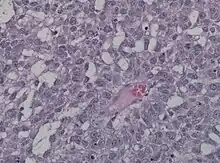Schiller–Duval body

Biopsy specimen of yolk sac tumor with Schiller-Duval body, H&E stain
Schiller–Duval body is a cellular structure seen by microscope in endodermal sinus tumors (yolk sac tumors) which are the most common testicular cancer in children. Schiller-Duval bodies are present in approximately 50% of these tumors, and if found are pathognomonic.[1] They are named for Mathias-Marie Duval and Walter Schiller[2] who described them in the late nineteenth century.[3]
Schiller–Duval bodies are said to resemble a glomerulus.[4] They have a mesodermal core with a central capillary, all lined by flattened layers of both visceral and parietal cells. Immunofluorescent stain may show eosinophilic hyalin-like globules both inside and outside the cytoplasm that contain AFP and alpha 1-antitrypsin.
References
- ↑ Kumar, Abbas, Fausto. Pathologic Basis of Disease, 7th edition. Philadelphia; Elsevier-Saunders, 2005. 1042.
- ↑ "Schiller–Duval bodies" at whonamedit.com
- ↑ Duval M. Le placenta des rongeurs. Journal de l'anatomie et de la physiologie normales et pathologiques de l'homme et des animaux, Paris, 1891, 27: 24–73, 344–395, 513–612.
- ↑ Kumar, Abbas, Fausto. Pathologic Basis of Disease, 7th edition. Philadelphia; Elsevier-Saunders, 2005. 1101.
This article is issued from Offline. The text is licensed under Creative Commons - Attribution - Sharealike. Additional terms may apply for the media files.